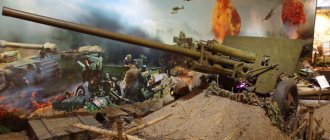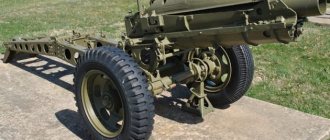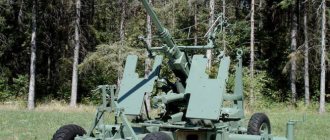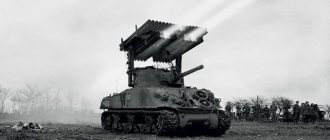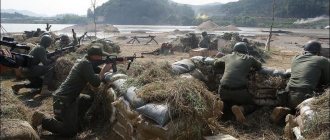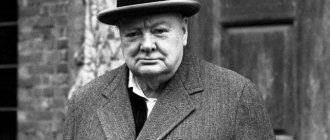Japanese anti-tank artillery in World War II
Japanese anti-tank artillery
. Japan entered World War II with an ocean-going fleet that fully met the highest world standards. Also, by the beginning of the 1940s, the Land of the Rising Sun had established mass production of combat aircraft that were not inferior to, and sometimes superior to, fighters, bombers, torpedo bombers and seaplanes that were available in the USA and Great Britain at the same period. At the same time, the Army of the Great Japanese Empire, financed on a residual basis, was equipped with equipment and weapons that largely did not meet modern requirements. The combat capabilities and numerical strength of Japanese artillery and tank units made it possible to successfully fight against poorly trained and poorly equipped Chinese units and colonial British and Dutch troops. But after a series of successes on land, Japanese ground forces, under pressure from American-British troops equipped with better equipment and weapons, were forced to first go on the defensive and subsequently retreat from the conquered positions. During defensive combat operations, the shortage and low combat performance of Japanese anti-tank guns had a full impact. The attempt of the Japanese command to strengthen the anti-tank defense with anti-aircraft guns can be considered partly successful, which, however, could not stop the Allied advance.
Crew of a 37 mm Type 11 infantry gun in a firing position
Anti-tank guns 37-47 mm caliber
The creation of specialized anti-tank guns in Japan began later than in other countries. Until the end of the 1930s, the main means of anti-tank defense of the front line was the 37-mm Type 11 infantry gun. It was a typical example of a “trench gun”, created on the basis of the French Canon d'Infanterie de 37 modèle 1916 TRP gun. The Type 11 was also fired using the 37x94R round.
37 mm Type 11 infantry gun
The design of the Type 11 gun was very simple, which made it possible to achieve minimal weight and dimensions. The recoil devices consisted of a hydraulic recoil brake and a spring knurler. Weighing 93.4 kg, the 37 mm gun could be carried by 4 people. For this purpose, the carriage had brackets into which poles were inserted. In total, including the ammunition carriers, there were 10 people in the crew. When disassembled, the gun was transported in packs on horses. To protect the crew from bullets and shrapnel, a 3-mm steel shield could be installed on the gun, but at the same time the weight increased to 110 kg.
Japanese 37-mm infantry gun Type 11 with a shield on display at the Central Museum of the Great Patriotic War of 1941–1945.
A gun with a manually opened vertical wedge breech could fire 10 rounds/min. A fragmentation projectile weighing 645 g was loaded with 41 g of TNT. With an initial projectile speed of 451 m/s, the effective firing range at point targets did not exceed 1200 m. The ammunition also included a cast iron armor-piercing tracer projectile, which made it possible to fight light armored vehicles at a range of up to 500 m.
Serial production of the Type 11 lasted from 1922 to 1937. Each regiment of the imperial army was supposed to have 4 37-mm infantry guns. The gun performed well in the early stages of the Second Sino-Japanese War, providing fire support to infantry and hitting various types of targets such as pillboxes, machine gun nests and lightly armored vehicles. 37-mm infantry guns were first used against Soviet armored vehicles and tanks in 1939 during the fighting at Khalkhin Gol. Several of these guns became trophies of the Red Army. After the advent of tanks with armor thickness of 30 millimeters or more, the 37 mm Type 11 guns became completely ineffective. Due to their low ballistic characteristics, they were “too tough” on the frontal armor of the American M3 Stuart light tanks, even when fired at short range. In addition, armor-piercing shells cast from cast iron in most cases shattered on the armor.
The weak projectile and short barrel of the Type 11 infantry cannon did not allow it to effectively fight armored vehicles. Already in the first half of the 1930s, it became clear that the Japanese army was in dire need of a specialized anti-tank artillery system. In 1936, mass production of the Type 94 anti-tank gun began. The design of this 37 mm gun was largely the same as the Type 11 infantry gun, but it was fired using 37x165R ammunition.
Anti-tank 37 mm Type 94 gun at the British Fort Nelson Museum
A 37-mm projectile leaving a 1,765-mm-long barrel with an initial speed of 700 m/s could penetrate 40-mm armor at a normal distance of 450 m. At a distance of 900 m, armor penetration was 24 mm. The weight of the gun in the combat position was 324 kg, in the transport position - 340 kg. A well-trained crew of 11 people ensured a combat rate of fire of up to 20 rounds/min.
However, there are certain doubts regarding the stated value of armor penetration. Thus, the German 37-mm anti-tank gun 3.7 cm Pak 35/36 with a barrel length of 1665 mm and ammunition 37x249R, firing an armor-piercing 3.7 cm Pzgr projectile weighing 685 g, with an initial speed of 760 m/s, at a distance of 500 m normally could penetrate 30 mm armor. Apparently, when assessing the armor penetration of Japanese and German anti-tank guns, different methods were used, and objectively the 37-mm Japanese gun was not superior to the German 3.7 cm Pak 35/36 anti-tank gun.
Japanese crew with a 37 mm Type 94 anti-tank gun
Possessing good ballistic data and rate of fire for its time, the 37-mm Type 94 cannon was in many ways an archaic design. The unsprung ride and wooden wheels covered with iron did not allow it to be towed at high speed. The gun could be disassembled into four parts, each of which weighed less than 100 kilograms, which made it possible to transport it in four packs on horses. A fairly low profile made it easier to camouflage on the ground, and the sliding frames with coulters contributed to a significant angle of horizontal fire of the gun and its stability during firing. To protect the crew from bullets and light fragments there was a 3 mm shield.
During the battles on the Khalkhin Gol River, 37-mm Type 94 anti-tank guns easily penetrated the armor of Soviet light tanks at real firing ranges. However, 37-mm shells were unable to penetrate the frontal armor of American Sherman medium tanks. However, the Type 94 remained the Japanese Army's most widely used anti-tank gun and was used until Japan's surrender. In total, army representatives received 3,400 guns by the second half of 1943.
In 1941, a modernized version of the 37-mm anti-tank gun known as Type 1 was adopted. The main difference was the barrel, lengthened to 1850 mm, which made it possible to increase the muzzle velocity of the projectile to 780 m/s. The weight of the weapon also increased.
Australian soldiers examining a captured Type 1 37 mm gun, Burma, January 1945
As with the Type 94, the Type 1 gun had a very low profile and was designed to be fired from a seated or prone position. Until April 1945, the Japanese industry produced about 2,300 Type 1s. The modernized 37 mm Type 1 guns were used along with the Type 94. Typically, each infantry regiment had six to eight Type 94 or Type 1 guns, and they were also equipped with individual anti-tank destroyer battalions .
At the end of the 1930s, as part of military-technical cooperation, documentation and several copies of 37-mm German 3.7 cm Pak 35/36 guns were delivered to Japan. Compared to the Japanese Type 94 gun, it was a much more advanced artillery system. According to archival data, Japan produced its own version of the 3.7 cm Pak 35/36, known as the Type 97. But very few of these guns were produced.
Taking into account the weak mechanization of the Japanese army and in connection with the specific conditions of combat in the Pacific theater of operations, where the firing range in the jungle in most cases did not exceed 500 m, it was very tempting to increase the armor penetration of 37 mm guns. Until the summer of 1945, work was underway in Japan to create a new light 37-mm anti-tank gun. Although already in 1943 it became clear that the 37-mm guns had practically exhausted their potential, Japanese designers did not abandon attempts to improve their armor penetration until the very end of the war. In particular, based on the 3.7 cm Pak 35/36, prototypes with an extended barrel were created, which used projectile cartridges with an increased amount of gunpowder. Field tests demonstrated that an all-metal armor-piercing projectile with a carbide tip, leaving the barrel at a speed of about 900 m/s, could penetrate 60 mm armor plate at a distance of 300 m, which made it possible to hit American medium tanks. However, the survivability of the barrel was only a few dozen shots, and the gun was not put into mass production.
Soon after the end of hostilities at Khalkhin Gol, the command of the Japanese army initiated the development of an anti-tank gun superior in its capabilities to Soviet 45-mm guns. A number of sources contain information that when creating the 47-mm Type 1 anti-tank gun, the designers of the Osaka Imperial Arsenal used the German 37-mm 3.7 cm Pak 35/36 gun as the initial model, increasing it proportionally in size.
47 mm Type 1 anti-tank gun
A prototype of the 47 mm gun completed testing in early 1939. Since the original version, designed for horse-drawn transportation, no longer met modern requirements for mobility, in March 1939 the gun received a sprung suspension and wheels with rubber tires. This made it possible to provide towing with mechanical traction, and in this form the gun was presented to the military. Simultaneously with the 47 mm, the development of a 57 mm anti-tank gun, which had greater armor penetration, was being developed. At the end of the 1930s, the creation of a powerful anti-tank gun was not among the priority programs of the Japanese army, and therefore, in order to save money, a 47-mm anti-tank gun was adopted.
The mass of the 47-mm gun in firing position was 754 kg. The total length of the barrel is 2527 mm. The initial speed of an armor-piercing tracer projectile weighing 1.53 kg is 823 m/s. According to American data, at a distance of 457 m, the shell, if hit at a right angle, could penetrate 67 mm of armor. An armor-piercing sub-caliber projectile with a tungsten carbide core was also created, which in tests penetrated 80 mm of homogeneous armor, but it was not mass-produced. A well-trained crew ensured a combat rate of fire of up to 15 rounds/min. The total number of gun servants was 11 people.
Staffing and tactics of Japanese anti-tank artillery
Serial production of the 47-mm anti-tank gun began in April 1942 and continued until the end of the war.
In total, about 2,300 Type 1 guns were produced, which clearly did not meet the needs of the Japanese army for anti-tank artillery. The Type 1 gun was supplied to individual anti-tank companies or battalions that were assigned to divisions. If deployed in a fortified area, one division could receive up to three battalions. Each individual anti-tank battalion had 18 47 mm guns. The motorized anti-tank battalion, which was part of the tank division, was also supposed to have 18 anti-tank guns. Separate anti-tank companies attached to motorized rifle regiments included three or four platoons of two guns each. Infantry regiments were assigned an anti-tank company, consisting of three fire platoons, each with two anti-tank guns. Taking into account the fact that the Japanese industry was unable to produce a sufficient number of 47 mm guns, 37 mm guns were used in many units. Depending on which divisions and regiments were assigned Type 1 anti-tank guns, trucks, tractors, or horse-drawn teams were used to tow them. To facilitate camouflage and reduce weight, armor shields were often removed from the guns. Widespread use of the Type 1 began in the summer of 1944 during the battles for Saipan and Tinian. A significant number of 47-mm guns were also used in combat operations in Southeast Asia. Approximately 50% of American armored vehicles in the Philippines were destroyed by 47 mm guns. By the start of the Battle of Iwo Jima, Japanese troops had 40 Type 1s on the island.
M4A2 Sherman knocked out on Iwo Jima by 47 mm gun fire
In the Battle of Okinawa, the Japanese garrison had 56 Type 1s. However, the Americans suffered the main losses in tanks from mines and land kamikazes. On the island of Guam, US Marines captured 30 47 mm guns.
A 47 mm Type 1 anti-tank gun with its armor shield removed, captured by US troops on the island. Guam
During the initial period of hostilities in the Pacific theater of operations, 47-mm Type 1 anti-tank guns easily hit M3/M5 Stuart tanks at actual combat distances. However, the effectiveness against the frontal armor of the M4 Sherman medium tank turned out to be significantly lower. According to American data, the Type 1 could hit the M4 head-on only from a distance of about 150 m. In one of the battles on Luzon, the Sherman received six hits at this distance, with five penetrations, while the armor-plated damaging effect was modest and the tank was quickly returned to service . According to some sources, a distance of less than 500 meters was required to reliably defeat the M4's side armor.
M4A3 Sherman of the 6th USMC Tank Battalion on Okinawa
The lack of effectiveness of the 47 mm anti-tank guns forced the Japanese to use ambushes and other methods to destroy the M4's side or rear armor and fire from short ranges, at which the front armor also became vulnerable. Japanese instructions prescribed waiting for the tank to reach a short distance by opening fire in order to increase the chances of hitting it for sure. According to the memoirs of the American military, Japanese troops were extremely skillful in placing and concealing anti-tank guns, and flexibly took advantage of terrain features and artificial barriers. Japanese tank destroyers, taking into account the location of the minefields of anti-tank barriers, placed anti-tank guns in such a way as to expose the sides of the tanks to their fire. To protect against 47-mm armor-piercing shells, American tankers hung additional sheets of armor on the Shermans, and also covered the hull and turret with spare tracks. This partly increased the protection of combat vehicles, but overloaded the chassis, reducing maneuverability on soft soils and reducing speed.
Unrealized projects of Japanese anti-tank guns
During the interwar period and during the Second World War, the Japanese leadership directed the main resources to the needs of the fleet and the improvement of combat aviation. The ground army was financed on a residual basis, and many promising types of anti-tank weapons were produced in very limited quantities or did not leave the test sites at all. Fortunately for American and Soviet tank crews, the Japanese did not consider it necessary to establish mass production of 57 and 75 mm anti-tank guns. Artillery systems of these calibers were tested at training grounds, demonstrating significant superiority over the 47 mm Type 01 cannons. Armor-piercing 57 and 75 mm shells at a range of 700-1000 m could confidently penetrate the frontal armor of medium tanks M4 Sherman and T-34-85. Apparently, the refusal to mass-produce anti-tank guns whose caliber exceeded 37-47 mm was explained not only by their higher cost and metal consumption, but also by the acute shortage of mechanized traction equipment in the Japanese army. Also, 81 and 105 mm recoilless rifles were not brought to mass production.
Experimental 81-mm recoilless rifle
Soon after, at the beginning of 1945, Japanese specialists became familiar with the captured 57-mm American M18 recoilless rifles, an 81-mm recoilless rifle was transferred for testing. The Japanese recoilless rifle was unprecedentedly light for such a caliber. The body weight of the gun was only 37 kg; the American 75-mm M20 gun, which appeared around the same time, weighed 54 kg. Initially, the 81-mm gun was mounted on the carriage of a 20-mm Type 97 anti-tank rifle, but after the first firing it was transferred to a simple tripod.
A cumulative projectile weighing 3.1 kg left the barrel at a speed of 110 m/s and normally penetrated 100 mm of armor. The effective shot range did not exceed 200 m. When conducting combat operations in the jungle, this would be enough, but the downside of the low weight was the low strength of the barrel. After several people died as a result of barrel ruptures at the test site, further development of the 81-mm recoilless rifle was abandoned, and the designers concentrated their efforts on the 105-mm recoilless rifle. At the same time, a number of sources based on the memories of Japanese veterans say that a small batch of 81-mm recoilless rifles nevertheless reached the front and were used in the battles for Okinawa.
In February 1945, the first sample of the 105-mm Type 3 recoilless rifle arrived for testing. With a mass in firing position of about 350 kg, the gun could be rolled onto the battlefield by crew forces. A charge of smokeless powder weighing 1590 g threw out a 10.9 kg projectile with an initial speed of 290 m/s. This made it possible to hit moving armored targets at a range of up to 400 m.
105 mm Type 3 recoilless rifle
A 105-mm cumulative projectile was capable of normally penetrating armor plates more than 150 mm thick, which was a mortal threat to all production tanks produced in 1945 without exception. Although there is no information about the creation of high-explosive fragmentation shells for the 105-mm recoilless rifle, a fairly powerful cumulative grenade containing more than 3 kg of powerful explosives could be effectively used against manpower. In general, the 105-mm Type 3 recoilless rifle had good characteristics, but the prolonged development and overload of the Japanese industry with military orders did not allow it to be accepted for service.
To be continued…
Links[edit]
- Evans, David C and Peattie, Mark R. (1997). Kaigun: Strategy, Tactics and Technology in the Imperial Japanese Navy, 1887–1941
Naval Institute Press, Annapolis, Maryland ISBN 0-87021-192-7 - Jansen, Marius B. (2000). The creation of modern Japan.
Cambridge: Harvard University Press. ISBN 9780674003347; OCLC 44090600 - Perrin, Noel. (1979). Abandoning the Cannon, Japan's Return to the Sword, 1543–1879.
Boston: David R. Godin. ISBN 0-87923-773-2 - Totman, Conrad. (1980). The Collapse of the Tokugawa Bakufu, 1862-1868
Honolulu: University of Hawaii Press. ISBN 0-8248-0614-X

